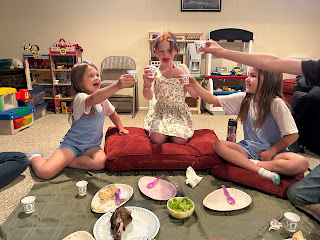This afternoon we drove to Granny's house to play and participate in Easter activities.
Penny and Diana in the car with their skates on.
Gorgeous day to be outside.
Easter/Passover decorations on the table.
Gideon, Uncle Doug, Sam, and Dad conversing before eating. Sam made some delicious pulled pork, which was quite appropriate for a Passover meal. 😁
Ari and Anders, with Dan Urbina in the background.
Jared, Rachel, Sara
Similar photo, but with Granny in it this time.
I thoroughly enjoyed catching up with my uncle, Doug, after not seeing him for almost 10 years. He's still as funny as ever!
This is the product of Uncle Doug's doodling.
The kids had fun doing an Easter egg hunt.
We participated in a traditional Passover meal. Granny and Grandpa (my parents) explained the stories behind the various foods.
Notes from my Mother:
The Passover meal is called a Seder meal.
The challah bread (on the left) is not used for Passover because it is leavened bread. But it is used every weekend for Shabbat as well as any other holidays.
The braids symbolize community connectedness as well as family.
Matza crackers symbolize the unleavened bread that the children of Israel took with them as they fled from Egypt. They didn’t want to use any yeast that would make it rise because it has to be baked as soon as it is risen.
The little clear cup containing salt water: they dip celery or parsley in the water and eat it to remind them of the tears they shed during slavery. The celery or parsley represents a new beginning and hope.
The crystal bowl contains a mixture of chopped apples, chopped walnuts, honey, and cinnamon. Charoset symbolizes the mortar used by the Israelites to build for the Egyptian pharaohs during their enslavement.
The little glass bowl contains a scoop of horseradish sauce. It symbolizes the bitterness of slavery to the Egyptians.
The lamb shank represents God's deliverance of the Israelites from slavery in Egypt, specifically the night when the blood of the lamb on their door posts caused the plague (the destroying angel) to pass over their homes.
There should be a cup of wine representing the blood of Christ, but we didn’t want purple grape juice all over the place so we used apple cider juice instead.
At Passover, wine symbolizes freedom and celebration, reflecting the liberation of the Israelites from slavery in Egypt. The tradition of drinking four cups of wine during the Passover Seder represents these four expressions of deliverance, including the words God used to promise deliverance: "I will bring out," "I will deliver," "I will redeem," and "I will take". It also symbolizes the joy and redemption experienced by the Jewish people.
A hard boiled egg was supposed to be in our food picture as well, but we ate them all at our meal. This is what ChatGPT says about the egg:
During the Passover Seder, the hard-boiled egg (called Beitzah in Hebrew) holds symbolic meaning, and it’s placed on the Seder plate for a few key reasons:
1. Temple Sacrifice Symbol: The egg represents the festival sacrifice (Korban Chagigah) that was offered in the Temple in Jerusalem during the festivals, including Passover. It serves as a reminder of what was lost when the Temple was destroyed.
2. Mourning and Loss: Because of that destruction, the egg also symbolizes mourning—eggs are a traditional food of mourners in Jewish custom. It reflects the sorrow over the loss of the Temple.
3. Hope and Renewal: On the flip side, the egg also stands for new life, spring, and hope—fitting with the Passover theme of renewal and freedom from slavery.
So while it’s a simple food, it carries layers of meaning—both grief and rebirth.
L'Chaim! (To Life!) The girls (and Maxwell's arm) toast each other with sparkling cider instead of wine.



























No comments:
Post a Comment